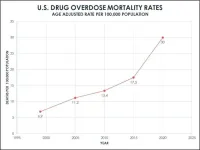(Press-News.org) Mount Sinai researchers have developed a novel, automated measure of analyzing sleep studies to determine the severity and risk of mortality in patients with obstructive sleep apnea, a chronic sleep disorder that affects about 30 million people in the United States. The study findings, which provide a validated tool to better manage sleep apnea and promote preventive care, were published in the American Journal of Respiratory and Critical Care Medicine on September 12.
The Mount Sinai Sleep and Circadian Analysis (SCAN) Group developed an automated breath-by-breath measure called ventilatory burden that assesses the proportion of small breaths during a routine sleep study. This novel measure is not dependent on the consequences of hypoxemia, or a low level of oxygen in the blood, and the awakenings seen in obstructive sleep apnea patients. The researchers define the normal range for ventilatory burden, assess its variability night to night, and show its relationship to obstruction in the upper airway. They also predict short- and long-term consequences based on a routine sleep study—including potentially deadly conditions such as coronary heart disease.
“The current clinical way of determining the severity of one’s sleep apnea is based on crude methods that do not predict risk of cardiovascular diseases or even mortality,” said corresponding author Ankit Parekh, PhD, Assistant Professor of Medicine (Pulmonary, Critical Care and Sleep Medicine) at the Icahn School of Medicine at Mount Sinai. “We have developed a way to analyze routine sleep studies to predict risk of cardiovascular diseases and even mortality. Clinicians who rely on arbitrary rules and thresholds for assessing severity of sleep apnea will now have a better validated tool to better manage sleep apnea and patients can receive the best care earlier.”
The primary diagnosis tool for obstructive sleep apnea is the Apnea-Hypopnea Index (AHI), which tells the average number of times per hour that breathing either partially or fully stops during sleep. However, this widely used standard only captures the rate of respiratory events and does not predict potential subsequent risks. Furthermore, calculation of AHI is influenced by various variables including scoring rules and other highly subjective baselines for breathing and oxygen saturation, rather than airway obstruction alone. AHI is also highly variable from one night to another. Thus, AHI is limited in describing the short- and long-term consequences of ongoing respiratory events overnight.
The researchers used data from two community cohorts evaluating disease conditions and patterns, as well as two retrospective sleep clinic cohorts, to derive the normative range of ventilatory burden from analysis of more than 34 million breaths from over 5,000 participants. The team then assessed the relationship between the degree of upper-airway obstruction and ventilatory burden, and the relationship between ventilatory burden and mortality risks, including cardiovascular disease, that were derived using an automated algorithm. They also assessed the relationship between ventilatory burden and hypertension and sleepiness.
They found that the automated measure of ventilatory burden was able to effectively assess the severity of obstructive sleep apnea, remain stable from one night to another, and predict mortality associated with cardiovascular diseases in patients, making it a viable alternative to AHI. The researchers said this study is the first time an alternative to AHI has been developed and investigated systematically, from establishing normal and abnormal cutoffs to assessing variability from one night to another and predicting risk of mortality.
The Mount Sinai team will next study an artificial intelligence algorithm built on top of the ventilatory burden to replace AHI and identify which patients will benefit from continuous positive airway pressure (CPAP) treatment, the first-line therapy in sleep apnea, preferably with a more racially and ethnically diverse patient dataset.
Data from the Brain Aging and Sleep Center at NYU Langone Health and the Federal University of São Paulo in São Paulo, Brazil, contributed to the research. The study was supported by funding and grants from the National Institute of Health’s National Heart, Lung, and Blood Institute (NIH K25HL151912, NIH R21HL165320), American Academy of Sleep Medicine Foundation (BS-233-20), and the Foundation for Research in Sleep Disorders.
About the Mount Sinai Health System
Mount Sinai Health System is one of the largest academic medical systems in the New York metro area, with more than 43,000 employees working across eight hospitals, more than 400 outpatient practices, more than 300 labs, a school of nursing, and a leading school of medicine and graduate education. Mount Sinai advances health for all people, everywhere, by taking on the most complex health care challenges of our time—discovering and applying new scientific learning and knowledge; developing safer, more effective treatments; educating the next generation of medical leaders and innovators; and supporting local communities by delivering high-quality care to all who need it.
Through the integration of its hospitals, labs, and schools, Mount Sinai offers comprehensive health care solutions from birth through geriatrics, leveraging innovative approaches such as artificial intelligence and informatics while keeping patients’ medical and emotional needs at the center of all treatment. The Health System includes approximately 7,400 primary and specialty care physicians; 13 joint-venture outpatient surgery centers throughout the five boroughs of New York City, Westchester, Long Island, and Florida; and more than 30 affiliated community health centers. Hospitals within the System are consistently ranked by Newsweek's® “The World's Best Smart Hospitals” and by U.S. News & World Report's® “Best Hospitals” and “Best Children’s Hospitals.” The Mount Sinai Hospital is on the U.S. News & World Report's® “Best Hospitals” Honor Roll for 2023-2024.
For more information, visit https://www.mountsinai.org or find Mount Sinai on Facebook, Twitter and YouTube.
END
Mount Sinai researchers develop novel, automated measure of sleep studies to determine severity of obstructive sleep apnea
2023-09-12
ELSE PRESS RELEASES FROM THIS DATE:
Fall snow levels can predict a season's total snowpack in some western states
2023-09-12
Spring break can be a good time for ski trips — the days are longer and a little warmer. But if people are booking their spring skiing trips the fall before, it's hard to know which areas will have the best snow coverage later in the season.
Researchers who study water resources also want to know how much snow an area will get in a season. The total snowpack gives scientists a better idea of how much water will be available for hydropower, irrigation and drinking later in the year.
A team led by researchers at the University of ...
Ten superintendents drive national initiative to champion health in schools
2023-09-12
With the start of the new school year, ten school system superintendents from coast to coast are working with the American Heart Association, a global force for healthier lives for all, to improve the health and well-being of students, families and educators nationwide. These top volunteer leaders, who are members of the association’s 2023-2024 national Superintendent Council will focus on providing guidance on how schools across the country can combat challenges that affect physical and mental well-being – contemporary issues like ...
City of Hope receives $100 million gift to create first-of-its-kind national integrative oncology program
2023-09-12
Photos, b-roll and video available for download in electronic media kit: https://t.ly/RRu-V. (Credit: City of Hope)
Event photos will be available at https://dam.gettyimages.com/assignments/city-of-hope-receives-100-million-gift.
(Event photo credit: Getty Images for City of Hope)
LOS ANGELES — City of Hope, one of the largest cancer research and treatment organizations in the United States, today announced a $100 million gift from Andrew and Peggy Cherng, philanthropists, co-founders and co-CEOs of Panda Express, to create a first-of-its-kind, national integrative oncology program that brings together Eastern and Western ...
A combination of cancer inhibitors shows success in slowing tumor growth
2023-09-12
An international team of researchers has demonstrated that a combination of inhibitors may suppress tumor growth and prevent relapse in patients with certain cancers, including head and neck squamous cell carcinoma and lung adenocarcinoma. Their findings support the future development of innovative therapeutic approaches targeting these cancers.
The team’s work is published in the journal Oncogene on August 17, 2023.
Scientists know that in humans and other mammals, the Hippo signaling pathway plays a key role in the rapid ...
In the age of ChatGPT, what's it like to be accused of cheating?
2023-09-12
While the public release of the artificial intelligence-driven large-language chatbot, ChatGPT, has created a great deal of excitement around the promise of the technology and expanded use of AI, it has also seeded a good bit of anxiety around what a program that can churn out a passable college-level essay in seconds means for the future of teaching and learning. Naturally, this consternation drove a proliferation of detection programs — of varying effectiveness — and a commensurate increase in accusations of cheating. But how are the students feeling about all of this? Recently ...
Researchers uncover NSMF protein’s role in relieving DNA replication stress
2023-09-12
A team of researchers from the Department of Biological Sciences at UNIST has achieved a significant breakthrough in understanding how brain proteins can help alleviate complications arising from DNA replication stress. This groundbreaking discovery holds immense potential for advancing treatments for various diseases, including cancer, neurological disorders, and age-related conditions that result from disruptions in DNA replication.
Led by Professor Jayil Lee, Professor Jang Hyun Choi, and Professor Hongtae Kim, this collaborative effort has unveiled crucial insights into ...
U.S. drug overdose deaths more than quadrupled from 1999 to 2020
2023-09-12
The United States is experiencing its highest overall death rates in more than a century, fueled in part by drug overdose mortality. The origins of the current epidemic are due, at least in part, to a 1986 World Health Organization pronouncement that pain treatment is a universal right. As such, cancer pain treatment guidelines were developed, which included the provision of opioids. In 1995, OxyContin was approved for the management of pain, paving the way for widespread prescription of opioids.
Researchers ...
Nicotine e-cigarettes, prescription drugs and dual nicotine replacement therapy identified as most effective stop-smoking aids
2023-09-12
Nicotine e-cigarettes and two prescription medications that curb symptoms of withdrawal are the most effective stop-smoking aids, according to a comprehensive, multinational review by a team of scientists, including a University of Massachusetts Amherst public health and health policy researcher.
Dual forms of nicotine replacement therapy (NRT), such as combining a patch with gum or a lozenge, were found to be nearly as effective.
Smoking remains the leading cause of preventable disease and death worldwide, and many people who want to quit smoking find it very difficult, due to the addictive nature of nicotine. The new study’s ...
Innovation thrives here: New report names Boston a top food tech hub
2023-09-12
In what’s known as the cluster effect, industries boom when similar businesses share a single locale. In San Francisco, there’s Silicon Valley. For cutting-edge fashion and media, there’s New York City. And according to a new report from the Friedman School of Nutrition Science and Policy at Tufts University, when it comes to innovation in food technology, Boston has become a bona fide magnet.
But what exactly is food technology, or food tech for short, and how can it solve the current food system’s most dire dilemmas?
The report from the Food and Nutrition ...
265-million-year-old fossil reveals oldest, largest predator in South America, long before the rise of dinosaurs
2023-09-12
Dinosaurs have quite the reputation for being the largest, fiercest predators in life’s history. Yet, 40 million years before dinosaurs ruled, Pampaphoneus biccai dominated South America as the biggest and most bloodthirsty meat eater of its time.
In a new study published in the Zoological Journal of the Linnean Society, an international team of researchers reveal the astounding discovery of a 265-million-year-old, exquisitely preserved fossil species, Pampaphoneus biccai, found in the rural area of São Gabriel, Southern Brazil.
The ...






